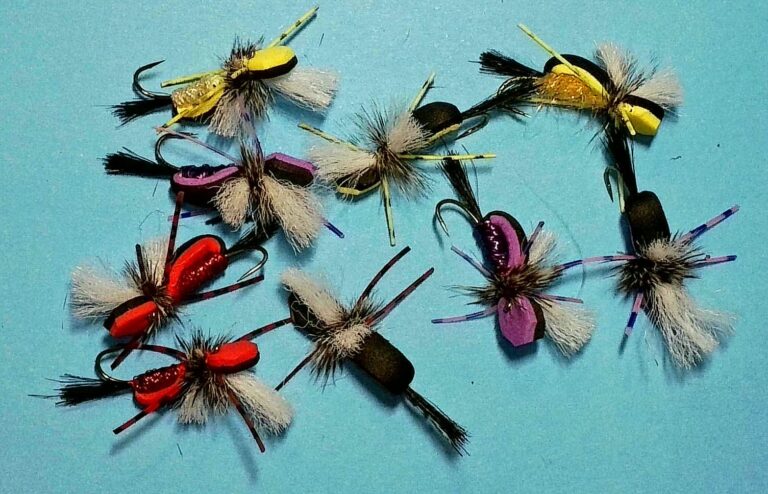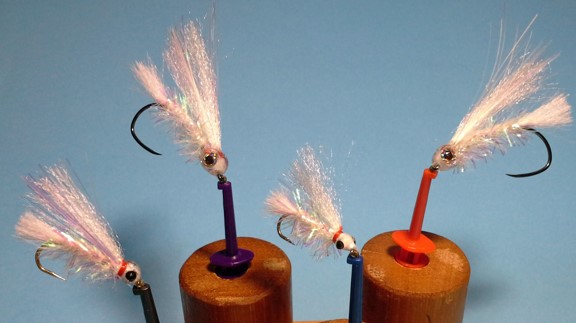
I first made this fly back around the turn of the century (I like saying that) to replace the small Dahlberg divers that I had begun using to fish for bream. They were too fiddly and time consuming to tie and didn’t last long.
I had been obsessed with catching whiting on fly since the late 80s with mixed success but had never used surface style flies on the coast other than for bass and maybe mullet during white ant hatches. The great revelation occurred while fishing the gurgler over a shallow bank in the lake in a very strong wind when there were prawns about. I was having fun dabbing the gurgler across the waves making it jump etc. when a whiting left the water to try for it in mid flight. I caught several in the same way in that session and have been taking them off the top with it ever since.
It’s primarily a whiting fly, but is also effective on bream, tailor, long toms and occasionally flathead. I have also caught herring, mullet, blackfish and I think Pete caught bass on it among other things. I’ve caught a few terns as well. They can be a nuisance by picking up the fly and dropping it out of the strike zone.It’s primarily a whiting fly, but is also effective on bream, tailor, long toms and occasionally flathead.
I have also caught herring, mullet, blackfish and I think Pete Glasson caught bass on it among other things. I’ve caught a few terns as well. They can be a nuisance by picking up the fly and dropping it out of the strike zone.
Materials
Hook – Size 8 Mustad 34007 stainless steel “O’Shaughnessy” (of course) are what I am using at the moment. Experiment with sizes if you like. The original hooks I used were Mustad short shank, wide gape size 9 stainless steel. Can’t find them these days.
Thread – Fluorescent pink seems to be the best but I might be superstitious. Tail – Polar fibre, Chartreuse seems to be the most attractive to fish. “Ocean green” is also good. Orange “fish fuzz” also works fairly well. Strangely enough I haven’t had much success with shrimp coloured polar fibre. The chartreuse and shrimp colours seem to be the least prone to matting of all the colours, including olive, black and white. Could be something to do with the dyes used.
Antennas – crystal flash or alternatively “Glitzy UV tinsel” which can be found in most fishing shops.
Eyes – burnt 20lb mono
Foam – Originally used closed cell from hockey shin guards. That is the right density to weight ratio. I still have some of that (at the time of writing) and also have some off cuts of similar density from Clark Rubber, though I haven’t seen that sort of thing there for a long time now.
Tying Instructions
Step 1
Tie in the polar fibre up to bend in the hook and add crystal flash antennas. The amount of polar fibre re thickness and length can vary. Flies with 4cm to 5cm lengths of polar fibre protruding from the hook get more hits especially on the drift. Shorter lengths may get more hook-ups but definitely are not as appealing to the fish. I’ve tried small stinger hooks but the fly doesn’t seem to move as well.
See Photos 1 and 2.


Step 2
Burn mono for eyes and tie in so that they protrude out a short distance. Not too far but they should be exposed when the foam is tied in as in picture. See Photos 3 and 4.


Step 3
Burn mono for eyes and tie in so that they protrude out a short Cut the foam so that it’s about 5ml thick and 2 cm long and 9ml wide. The foam I use is in a sheet, which is 9ml thick. That thickness of the sheet provides the width of the cut foam used on the fly. Think about it.

Cut the foam as shown in the photo. Also taper some thickness off the part of the foam that is tied along the shank. This enables the fly to be less buoyant at the back and sit hook down in the water a bit like a mayfly emerger.
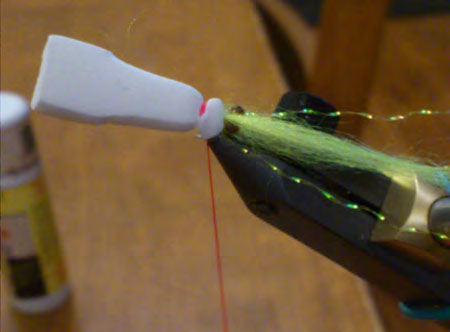
The tail, antennas and eyes sit under the water at about a 30 degree angle. The wedge of foam at the front sits above the water. Tie in the foam at the bend of the hook as in the photo. If you happen to cover the eyes just cut the offending bit of foam off after tying.
See Photos 5 and 6. Photo 7 shows where I have roughly tapered the foam.
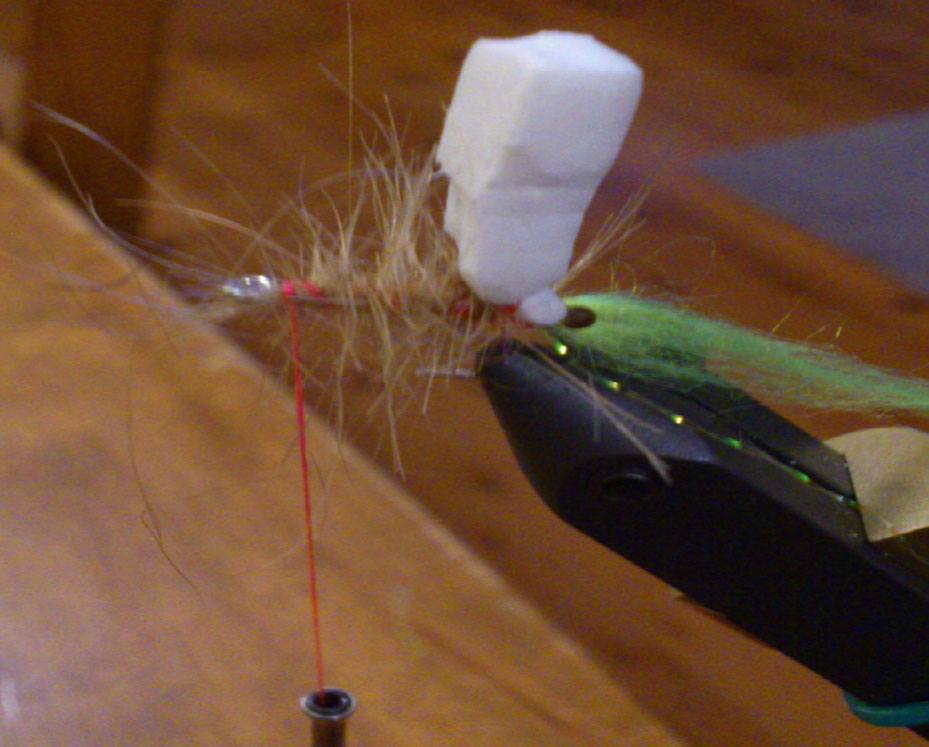
Step 4
Bend the foam up to give yourself room to dub in the hairy legs along the hook shank. Human hair is a bit difficult to handle but manageable if only a small amount of dubbing wax is used (I’m not sure I should have said that). See Photo 7.
Step 5
Tie in the other end of the foam next to the hook eye at the place where the foam changes into a wedge shape, see photos. I try to estimate the length of foam used so that I need to squeeze and stretch the “on shank” part a little to position the narrow part of the wedge just in front of the hook eye. That way the foam along the hook isn’t as buoyant and the front part of the fly will sink. There is a balance, of course, as you don’t want the fly to hang in the water too far towards the vertical. At least I think you don’t. It certainly won’t jump as well.
The proportions in the photos are pretty close. The wedge section should be 8ml to 10 ml long, no longer for this size hook. The length has an effect on how much the leader will twist.
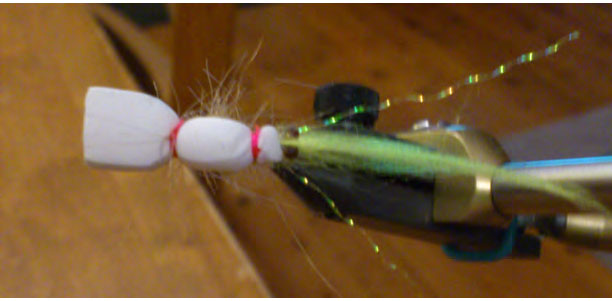
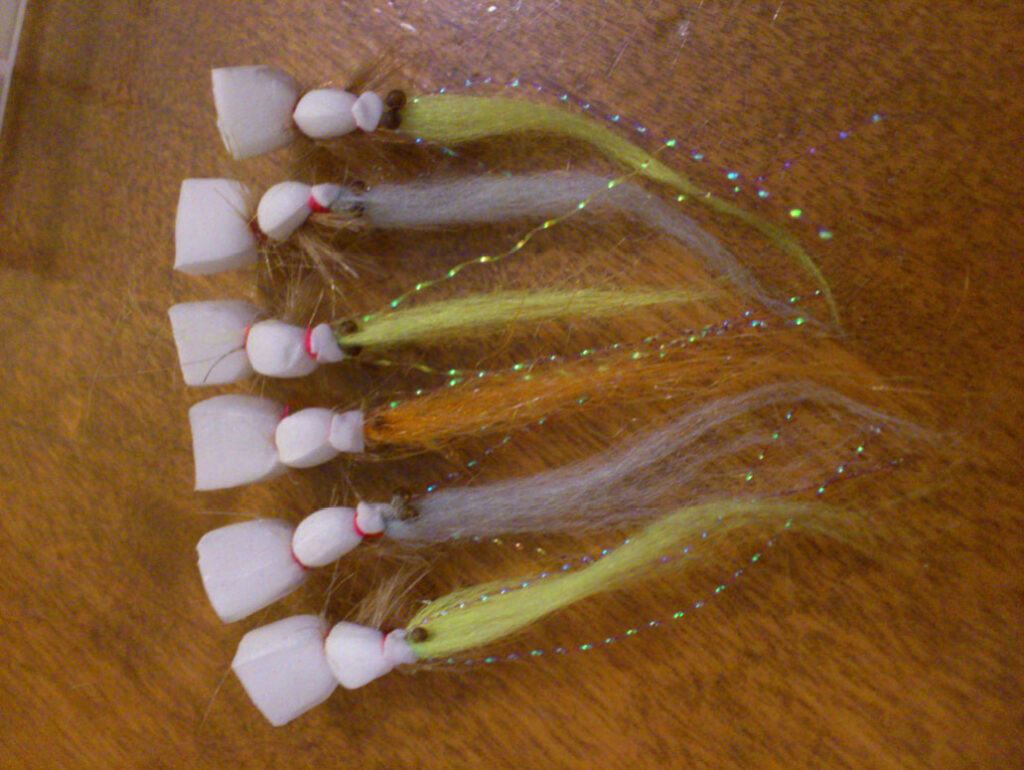
Step 6
Apply a couple of coats of hard as nails or similar to thread areas, allow it to dry and then go fishing.
The build has evolved a little over the last 10 or so years just through general tying. The present version seems to function efficiently but I’m not sure it catches more fish. Then again I haven’t been fishing as often as previously. See what you can come up with.
Fishing the JOS Gurgler
A strong tippet is needed to lessen twisting of the leader when casting and retrieving. I generally use 12lb or 15lb mono tippet on a 9 or 10 ft leader. The fish don’t care. Use a loop knot. Also check Morsie’s leader recipe. I’ve been using it lately and they work well. A simpler one that’s OK is a metre of 30lb, a metre of 25lb, a metre of 20lb and couple of feet tippet of 15lb or even add a length of 12lb onto that.
The retrieve doesn’t need to be fast. Sometimes whiting respond better to a constant series of bloops. Sometimes just a couple of initial “here I am” bloops will get them interested enough to find it and hit it on the drift. The shape of the foam causes the fly to do little jumps just like a prawn.
The polar fibre has great movement in the water and the fly’s silhouette is a fair representation of a prawn. Often fish will drag it under the surface. Keep retrieving and it will be taken. It wobbles around attractively when retrieved under water. I haven’t yet tried it on a sinking line in impoundments. It might be good for perch or trout. It is most effective when prawns are about but I have had great sessions sight fishing for them in the middle of winter in very shallow water with a decent wind wave, the windier and stormier the better.
I once rigged the gurgler, for an occasional spin fisher, about 3 ft behind a bubble float on a spinning rod. It was even more effective. The fish were aggressively attracted to the commotion caused by dragging the bubble float through the water and then fought over the fly. No subtlety at all. He bagged out several days running.
Sometimes whiting can be found up the lake in shallow, very calm water, with backs and tails showing digging in the silt. I have had more success at those times dropping a very small sinking shrimp pattern into the little silt cloud caused by their rooting around. The gurgler is very effective fishing for bream in the shallows up to about waist deep. Land the fly along a drop off or depression and give it one little bloop. Wait 15 to 30 seconds for a swirl near the fly. Then give it another little pull and all being well a bream will hit it. Bream seem to take a little while to locate it. Tailor, sometimes behave in a similar fashion. Mostly it is almost impossible to keep it off them.
Don’t know why black fish have eaten it but maybe the tail looks like green weed waving about. Hope all this makes sense.
John O’



